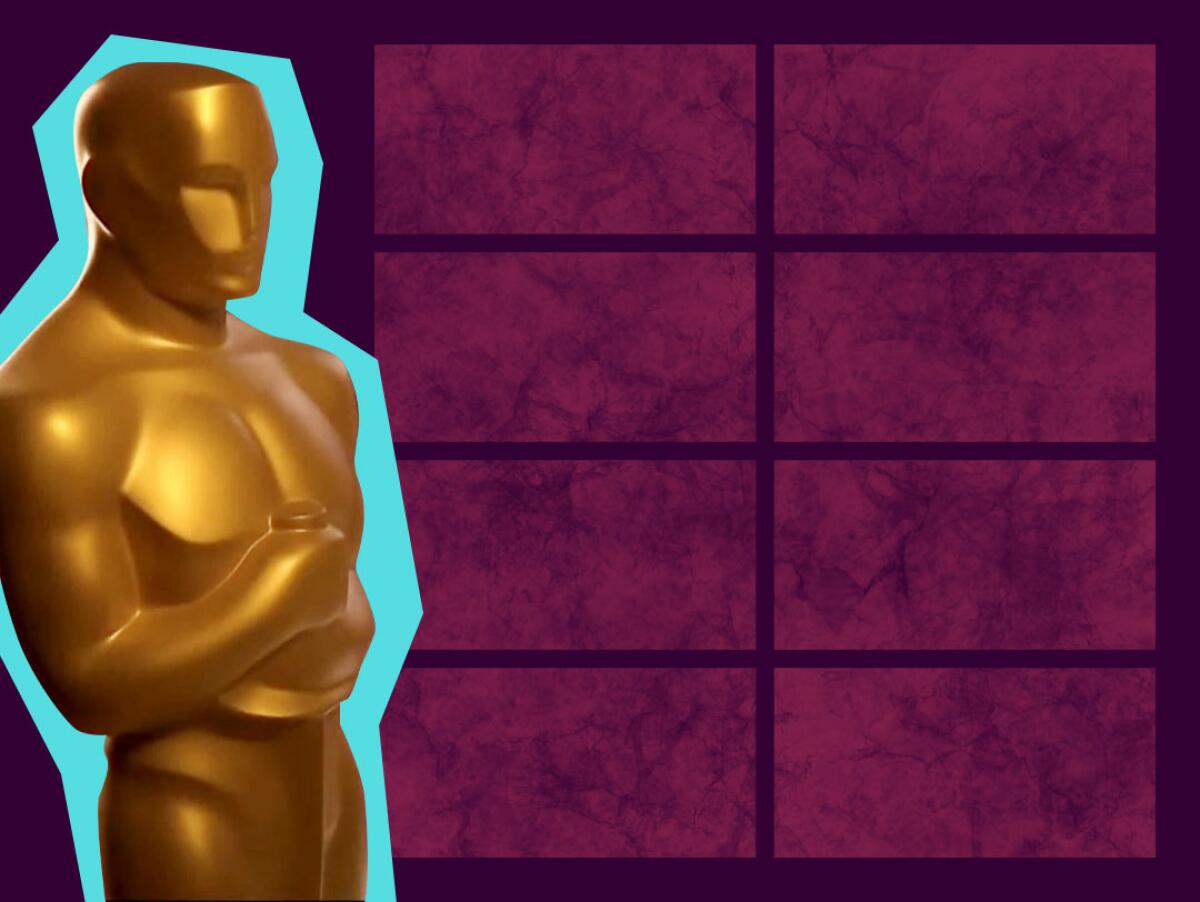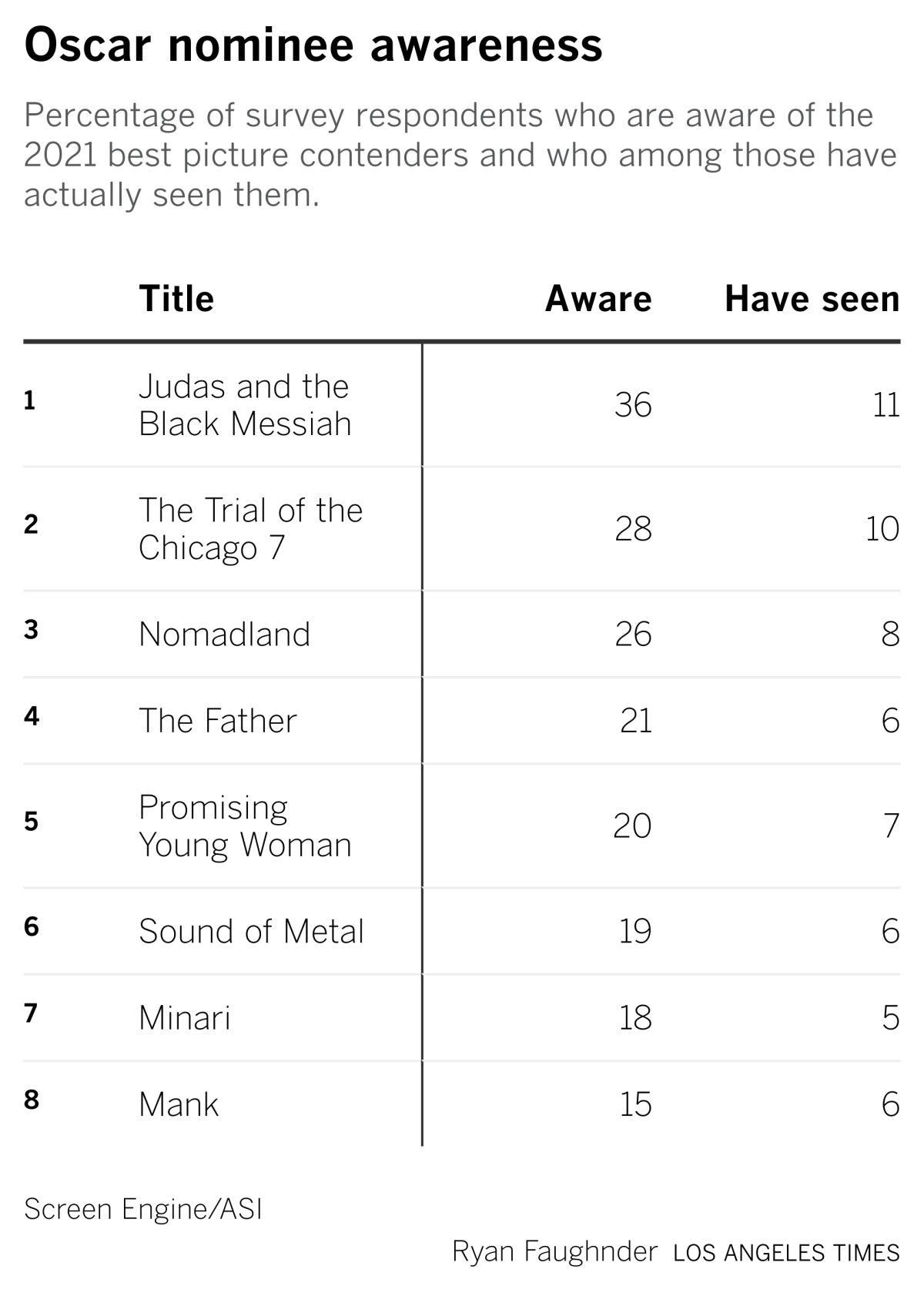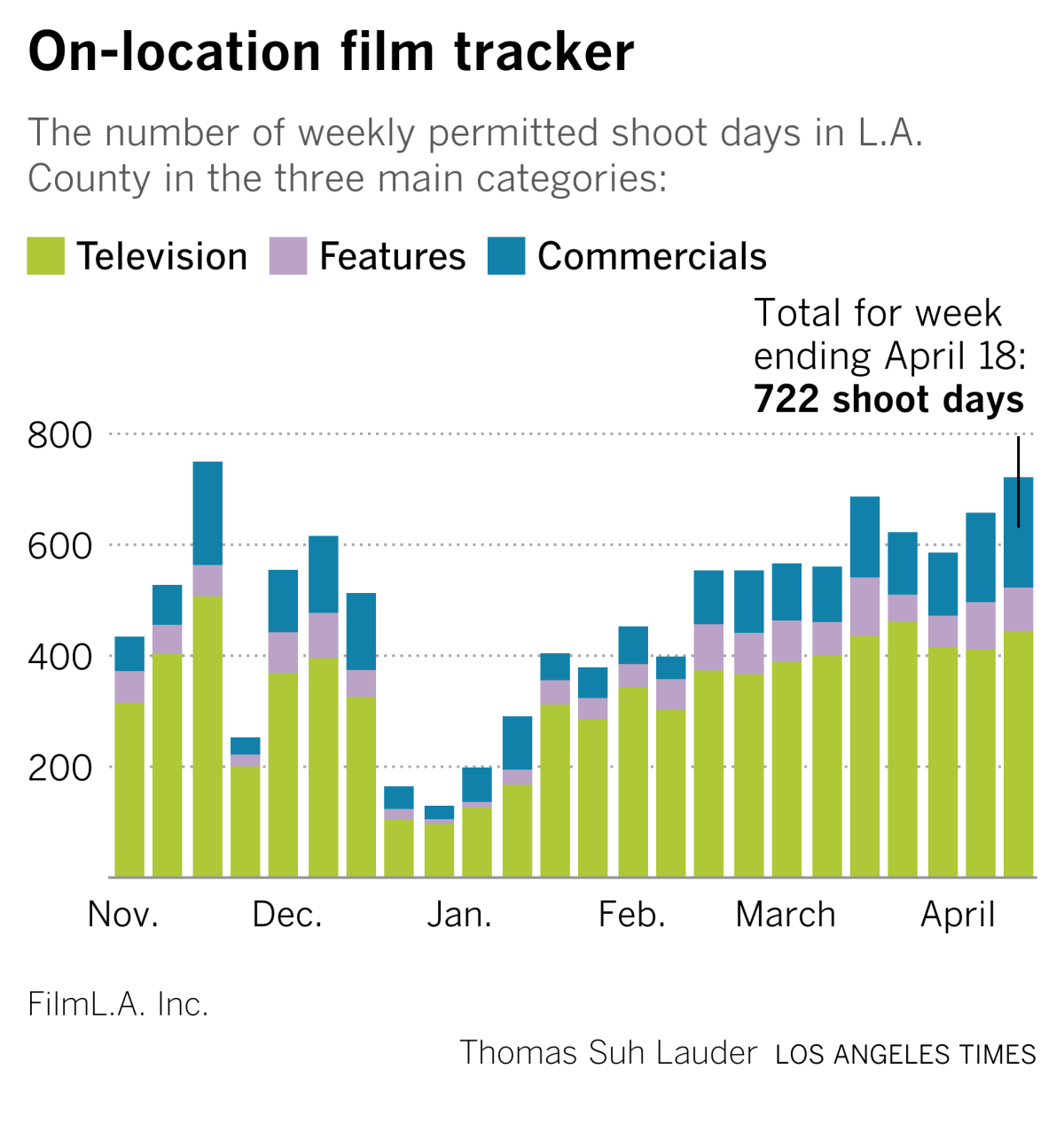Is there a cure for the Oscar blues?

This is the April 20, 2021, edition of The Wide Shot, a weekly newsletter about everything happening in the business of entertainment. Sign up here to get it in your inbox.
Welcome to Oscars week, 2021. Once the Academy decided the show would go on, there was probably not much anyone could have done to prevent this awards season from feeling like the ultimate Zoom meeting that could have been an email.
With Searchlightâs âNomadlandâ cruising toward probable Oscar glory Sunday night, the biggest question of the film industryâs lost year isnât who will win the top prize, itâs how low will the ratings sink. With 12 million to 15 million as the industry consensus estimate, viewership is doomed to deteriorate fast from last yearâs low of 23.6 million viewers.
Analysts will rightly blame a lineup of little-seen best picture nominees, plus the utter strangeness of celebrating movies in a year that most big films skipped and a pandemic that has brutalized awards show viewership (as my colleague Stephen Battaglio reported recently).
The Oscar producers, who include Steven Soderbergh, are doing their best not to add Zoom fatigue to the long list of problems, declaring that there will be no accepting awards via the ubiquitous video service.
Instead, those who canât make it to Los Angeles for the show (broadcast from Union Station and the Dolby Theatre) can participate from a separate hub in the U.K. and a bunch of satellite feeds. âItâs the fâing Oscars. Itâs not a webinar,â Soderbergh told The Timesâ Josh Rottenberg.
Through the Hollywood Reporter, the producers promised a âjoyousâ ceremony, clearly responding to anyone dreading a dreary proceeding of Hollywood self-congratulation and self-flagellation after a year like weâve had.
Inside the business of entertainment
The Wide Shot brings you news, analysis and insights on everything from streaming wars to production â and what it all means for the future.
You may occasionally receive promotional content from the Los Angeles Times.
The biggest problem, according to informal industry consensus, is that not enough people have seen, or even heard of, the nominees for the top prize.
A recent survey of 1,435 people who either watched a movie at home or in a theater in the last year found a high percentage of consumers werenât aware of the Oscar best picture nominees, according to Screen Engine/ASI. The highest awareness was for Warner Bros.â âJudas and the Black Messiah,â at 36%. Of those people who were aware of the film, 11% had actually seen it. The lowest awareness was for Netflixâs âMankâ at 15%.

Awareness and viewing rates were generally higher among moviegoers, defined by Screen Engine/ASI as those who went to the movies at least once every two months before theaters were closed and are willing to return to theaters soon after they reopen. For example, of the 451 moviegoers polled, 43% were aware of âJudasâ and 21% of those people had watched it.
Of course, most of the movies nominated this year were primarily seen through streaming, rather than in theaters. Netflix is coming in with 36 nominations (up by one after the official announcement that the company acquired the live-action short âTwo Distant Strangersâ), and Amazon Studios is in the double digits too.
But can the lack of awareness really be streamingâs fault? Movies released online are available to more people at a much lower cost. On the one hand, they should be able to reach the public more easily. If you want to see âNomadland,â itâs cheaper and easier than it ever would have been before, thanks to Hulu.
And itâs clear that some movies have been able to break through via digital release. âComing 2 America,â acquired from Paramount by Amazon, was no oneâs idea of an Oscar contender, but it topped the Nielsen streaming chart for two weeks. âBorat Subsequent Moviefilmâ clearly made an impression through various marketing stunts and unbeatable timing with the 2020 election.
On the other hand, theatrical releases do have a way of âeventizingâ films, creating that sustained level of awareness that jams a film in the publicâs consciousness. Studios havenât quite figured out how to create the same effect when it comes to their online releases.
âThe studio model is really geared to bringing butts in seats into the theater,â said Mike Chapman, a veteran media business consultant at Kearney. âIt is less geared to secondary or tertiary channels like streaming.â
Still, reasons for the lack of awareness and viewership probably have more to do with the list of movies itself, which, while chock-full of worthy art, doesnât include much in the way of crowd-pleasers such as âLa La Land,â âThe Shape of Waterâ and âGreen Book.â
There are plenty of reasons to appreciate this yearâs Oscar nominees, between the new filmmakers and the recognition of women and people of color, but feel-good vibes are not among them. A recent âReal Time With Bill Maherâ segment dunked on the âdread carpet,â as the comedianâs Chyron artists put it. âBrought to you by razor blades, Kleenex and rope,â Maher quipped. âAnd please welcome our host, the sad emoji.â
To the average viewer, unfortunately, itâs more like the shrug emoji.
ArcLight of the covenant

If Decurion Corp.âs goal was to set off a film community panic over the closing (or really, non-reopening) of ArcLight Cinemas last week, it was a stunning success.
We wrote of the fallout among movie directors, the growing tension between cinemas and landlords and the snafu that was the debut of the Small Business Administrationâs Shuttered Venue Operator Grant program. Jessica Gelt explained the long list of unlikely things that would have to happen before a developer could do the unthinkable and turn the beloved Cinerama Dome into a Target or an Outback Steakhouse or something. Mary McNamara waxed nostalgic about her family outings to the Pasadena ArcLight.
Will Netflix, or another streamer, studio or famous filmmaker, pull an Egyptian Theatre and buy the landmark Sunset Boulevard location, as Twitter users have hoped? It depends on any buyerâs appetite to get into the theatrical exhibition game, which was having issues even before the pandemic.
ArcLightâs demise is an emotional hit to Los Angeles and its community of filmmakers and moviegoers. But given the economic pressures on theaters, itâs surprising more operators havenât gone under.
More stuff we wrote
â The Golden Globes fallout continues: Former HFPA president Phil Berk faces a backlash over an email calling Black Lives Matter a âhate movement.â Stacy Perman has the scoop.
â Media deal of the week: Spanish-language media giants Univision and Televisa to merge. From Meg James: Televisa valued its assets at $4.8 billion. Univision will pay Televisa $3 billion in cash and provide $750 million in Univision common equity and $750 million in Series B preferred equity.
â TV newsâ revolving door: ABC News taps Kim Godwin as president, a milestone for the broadcast industry. Michael Corn is out as senior executive producer of ABCâs âGood Morning America.â CBS combines news, TV stations group and taps new leaders after a Times investigation.
â Ladies and gentlemen, the article about the âladies and gentlemen, the weekendâ meme.
â Hollywood production: Movie and TV sets and offices are inching back to normal, sort of. There are still plenty of hurdles, even as vaccinations spread and restrictions lift. Some things may never get completely back to the way they were. Hereâs the latest data for filming in the Greater Los Angeles area.

NFTease
Proponents of NFTs (or non-fungible tokens) have touted them as godsends to independent artists looking for new ways to capitalize on their work.
Take the experience of JosĂŠ Delbo, an 87-year-old scribbler of superheroes highlighted in Matt Pearceâs story on the NFT craze. Delboâs experiment selling his art on the blockchain paid off. Pearce writes: âThis spring, as the rest of the world was scrambling to understand the NFT phenomenon, fans paid the equivalent of nearly $2 million for a set of NFTs by Delbo and the two-person artist team Hackatao featuring DC Comics character Wonder Woman.â
Entertainment-related entities have been piling into NFTs, with Kings of Leon releasing an album with NFT bonuses and film financier Forest Road creating a platform for movie producers to sell digital collectibles.
There are tons of NFT explainers out there (hereâs Sam Deanâs good one from last month). Basically, theyâre digital certificates of authenticity for digital goods. Whether this a speculative shell game in which early Ethereum investors are patronizing the arts with crypto Monopoly money is a debate for a different newsletter.
The most interesting part of Pearceâs story is where the studios and comic book publishers get involved.
Shortly after Delboâs sale, DC â which like Marvel long has allowed artists to sell original ink-and-paper drawings used in comic books â sent a notice to artists forbidding the minting of NFTs with DC characters.
âAs DC examines the complexities of the NFT marketplace and we work on a reasonable and fair solution for all parties involved, including fans and collectors, please note that the offering for sale of any digital images featuring DCâs intellectual property with or without NFTs, whether rendered for DCâs publications or rendered outside the scope of oneâs contractual engagement with DC, is not permitted,â said the letter from Jay Kogan, DCâs senior vice president for legal affairs.
Marvel sent a similar notice after artists auctioned NFTs of their original artwork of Marvel characters.
It certainly didnât take long before Warner Bros. and Walt Disney Co. started to try to establish a copyright moat around this trendy form of artistic commerce.
Number of the week

Teens and young adults significantly prefer playing video games to watching movies and TV shows at home, according to a survey released Sunday night by consulting firm Deloitte.
Twenty-six percent of Gen Zers, defined as those born from 1997 to 2007, cited playing video games as their favorite entertainment activity, compared with 14% for listening to music, 12% for browsing the internet and 11% for engaging on social media. Only 10% said they would rather watch a movie or TV show at home. For what itâs worth, books clocked in at 5%.
That compares to millennials (born 1983 to 1996), 18% of whom chose watching movies and TV shows as their preferred mode of entertainment. Video games were the entertainment option of choice for 16% of millennials.
Video gamesâ cultural currency is undeniably growing as more young people use them as their way of interacting socially. Check out this graph that business strategist Matthew Ball shared on Twitter showing the growth of video game revenue, particularly on mobile devices.
Other interesting data from Deloitteâs survey:
- 61% of total respondents said video games helped them get through a difficult time.
- 53% said video games help them keep in touch with people.
- 46% said video games have taken away from other entertainment activities.
More top stories from the web
â Gulp! Amazonâs âLord of the Ringsâ series will cost at least $465 million for its first season. (CNBC)
â The fight for the soul of Bravo: A year of national reckonings on race and inequality has tested how real the Housewives should be. (Vulture)
â South Korea and Japan emerge as key battlegrounds in the streaming wars. (THR)
â The redemption of Justin Bieber: How the pop idol is putting his life back together one step at a time. (GQ)
â The CEO of AMC went on a YouTube show called âTreyâs Tradesâ to explain his latest stock moves. (THR)
Finally ... going to chvrch
New music from Scottish electro-pop band Chvrches is always good news.
ONE FOR ME: Your mileage with Detroit-based hardcore band the Armed will depend on your tolerance for blast-beat drumming and screaming vocals (mine is pretty high). The bandâs latest album, âUltrapopâ (styled ULTRAPOP), is a scorcher.
Inside the business of entertainment
The Wide Shot brings you news, analysis and insights on everything from streaming wars to production â and what it all means for the future.
You may occasionally receive promotional content from the Los Angeles Times.




